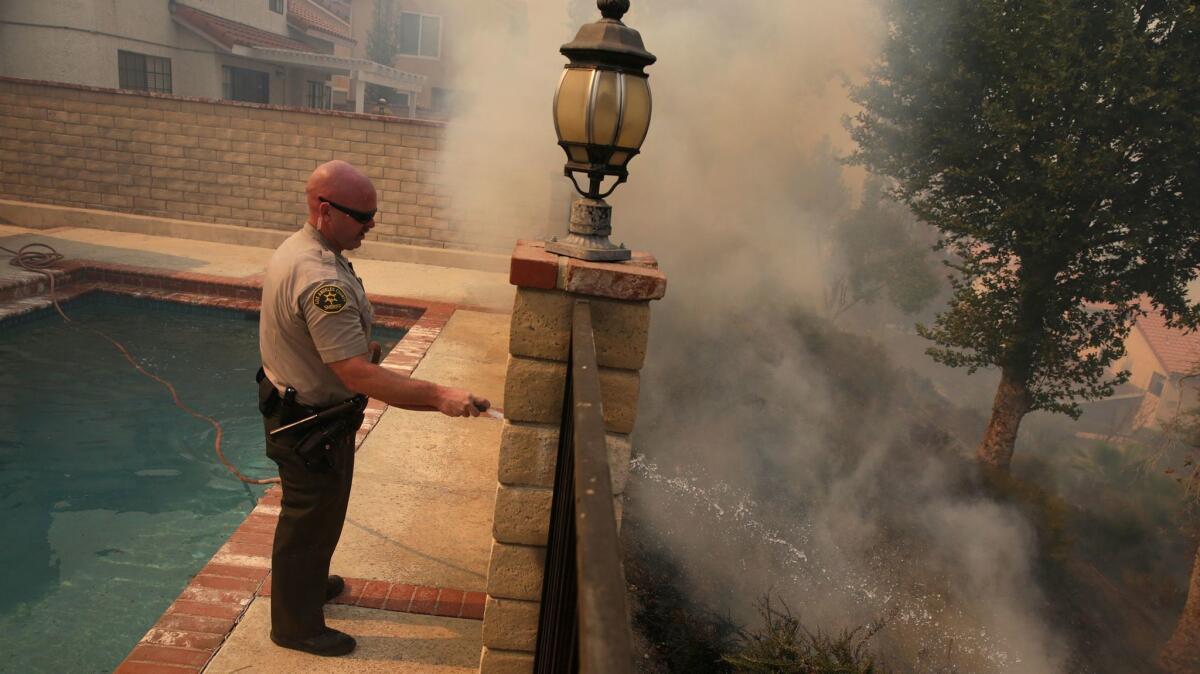Q&A: ‘Firescaping’ an HOA’s property takes real expertise but can’t be ignored in Southern California

Question: We live in a 60-year-old town home community and have been casualties of drought, heat, wind and fire.
A few years ago our homeowner association board replaced some of the common area vegetation with drought-tolerant landscaping, but they left all the original mature pine, eucalyptus and fan palm trees in place. That includes rows of arborvitae that are used as windbreakers, but there are dead trees within the rows. We’ve now got fountain grass and fern pines, and since installing the new landscape there have been several fires that caused some trees to ignite, causing significant damage.
The board refuses to remove any of the mature trees no matter the hazard. How dangerous is our vegetation? Is this landscape salvageable? What can we do to fix it?
Answer: Flammable trees and vegetation are a community hazard and removing them is the board’s safest option. Once the board was put on notice of the dangerous conditions existing in your development, it had a fiduciary duty to correct the problem and maintain the association’s property — a process known as “firescaping.”
“Vegetation will either lead a fire to a structure or stop it. What is key is that all plants become flammable with age and neglect,” said Douglas Kent, a lecturer on ecological land management at Cal Poly Pomona who has written a book on firescaping.
The process, in this case, should start with the board instructing gardeners to maintain the existing vegetation, including removing a tree’s dead limbs, branches and leaves on a regular basis. The ground also must be kept clear of flammable material and be irrigated deeply. Depending on your geographical location, a drip irrigation system may not fulfill your landscaping requirements.
But the board should consider rethinking the association’s landscaping plans and planting new vegetation that will better protect the town home community in the event of future fires.
Given your association’s fire risk, the decision to leave eucalyptus, fan palm trees and pine trees is not a good idea. Eucalyptus and fan palms are highly flammable if poorly maintained, while pine trees also present a fire danger unless regularly irrigated.
The board’s decision to install fountain grass also might not have been the best choice since, like most grasses, it becomes more flammable with age. Aborvitae is also flammable because of its small resinous leaves. Fern pines, on the other hand, hold a lot more moisture and produce a lot less ignitable material. If kept clean, fern pines can catch embers without igniting.
There are five general preventative steps that associations can take to protect their communities against fire, according to Kent.
First, the board and association members must ask themselves: Can the roads safely and swiftly lead emergency personnel to a structure?
Second, are the structures in good condition? Are the surfaces in decent shape, the eaves and air vents protected, and outside debris stored away from the walls?
Third, what does the first 30 feet of landscaping nearest a home look like? Is the vegetation well cared for, are all the dead, dying and diseased plant material removed?
Fourth, what does the landscape 100 feet from your landscape look like? Has dead material been removed and flammable weeds taken out, and is there ample distance between shrubs and trees?
Fifth, what types of community resources are on hand, such as evacuation plans, backup power, water and emergency communications?
In 2005, California passed a law that requires homes in high-risk fire areas to have 100 feet of “defensible space” surrounding them, meaning the ground is planted with vegetation that reduces the risk of a fire reaching a structure.
A landscape design model used to ensure compliance with state law was developed in the early 1960s by the Los Angeles Arboretum. It is called the Zone Theory and has been adopted throughout the world.
It is based on the idea of four concentric zones radiating out from a structure to a distance of 120 feet on level ground, and even further on a slope.
The first zone, or Garden Zone, extends 30 feet from the structure and is designed and maintained to withstand an onslaught of embers. The second zone, or Greenbelt, extends 70 feet and its goal is to stop a ground fire. The goals of zones three and four are to reduce the severity of a fire. Zone three extends to 120 feet from a structure and zone four is everything beyond that.
Zone one should be planted with fire-retardant plants, which sizzle when exposed to flames and intense heat but rarely ignite. Examples of fire-retardant plants include Agapanthus spp. (lily of the Nile), Heuchera spp. (coral bells) and roses. Succulents and cacti are also fire-retardant.
Zones two and three should be planted with fire-resistant plants, which may ignite, but let the fire quickly pass through and then quickly re-sprout after the fire, helping to reduce topsoil loss and erosion from winter rains. Fire-resistant plants are more drought-adapted and include Achillea spp. (yarrow), Cistus spp. (rockrose) and Malva assurgentiflora (island mallow).
Homeowner associations are not in the business of maintaining plants. They are in the business of maintaining communities. Plants should take a back seat to public health and safety, community satisfaction and well being. When the plants become the priority, safety suffers. Not only does flammability rise but sidewalks and driveways also start lifting and pruning and cleaning costs increase. A landscape that protects a community prioritizes renewal and plans for replanting.
For more tips on firescaping, consult Kent’s book, “Firescaping: Creating fire-resistant landscapes, gardens and properties in California’s diverse environments.”
Vanitzian is an arbitrator and mediator. Send questions to Donie Vanitzian, JD, P.O. Box 10490, Marina del Rey, CA 90295 or [email protected].
More to Read
Inside the business of entertainment
The Wide Shot brings you news, analysis and insights on everything from streaming wars to production — and what it all means for the future.
You may occasionally receive promotional content from the Los Angeles Times.










